2013 MERCEDES-BENZ CLA COUPE weight
[x] Cancel search: weightPage 23 of 373
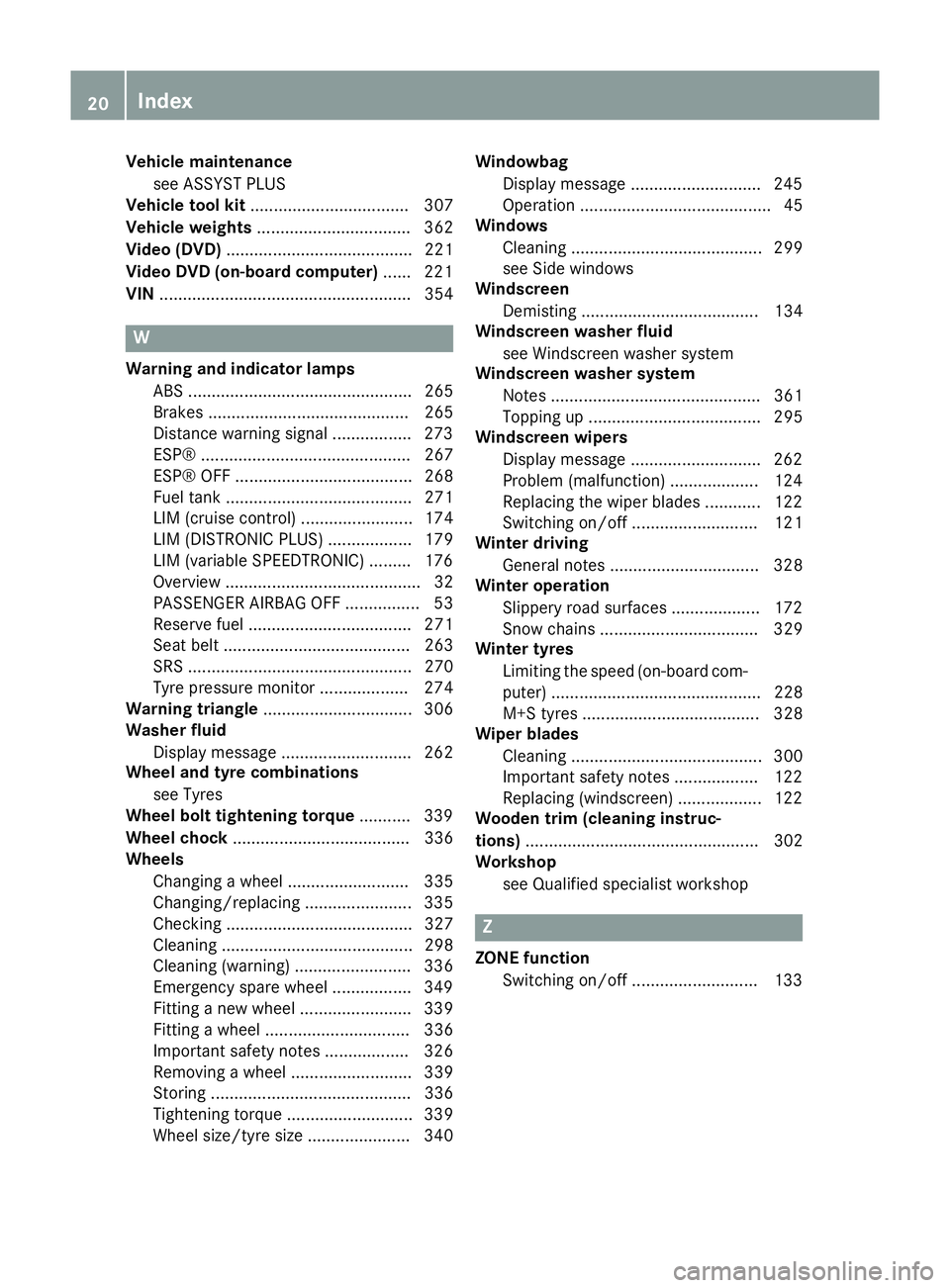
Vehicle maintenance
see ASSYST PLUS
Vehicle tool kit .................................. 307
Vehicle weights ................................. 362
Video (DVD) ........................................ 221
Video DVD (on-board computer) ...... 221
VIN ...................................................... 354 W
Warning and indicator lamps ABS ................................................ 265
Brakes ........................................... 265
Distance warning signal ................. 273
ESP® ............................................. 267
ESP® OFF ...................................... 268
Fuel tank ........................................ 271
LIM (cruise control) ........................ 174
LIM (DISTRONIC PLUS) .................. 179
LIM (variable SPEEDTRONIC) ......... 176
Overview .......................................... 32
PASSENGER AIRBAG OFF ................ 53
Reserve fuel ................................... 271
Seat belt ........................................ 263
SRS ................................................ 270
Tyre pressure monitor ................... 274
Warning triangle ................................ 306
Washer fluid
Display message ............................ 262
Wheel and tyre combinations
see Tyres
Wheel bolt tightening torque ........... 339
Wheel chock ...................................... 336
Wheels
Changing a whee l.......................... 335
Changing/replacing ....................... 335
Checking ........................................ 327
Cleaning ......................................... 298
Cleaning (warning) ......................... 336
Emergency spare wheel ................. 349
Fitting a new wheel ........................ 339
Fitting a wheel ............................... 336
Important safety notes .................. 326
Removing a whee l.......................... 339
Storing ........................................... 336
Tightening torque ........................... 339
Wheel size/tyre size ...................... 340 Windowbag
Display message ............................ 245
Operation ......................................... 45
Windows
Cleaning ......................................... 299
see Side windows
Windscreen
Demisting ...................................... 134
Windscreen washer fluid
see Windscreen washer system
Windscreen washer system
Note s............................................. 361
Topping up ..................................... 295
Windscreen wipers
Display message ............................ 262
Problem (malfunction) ................... 124
Replacing the wiper blades ............ 122
Switching on/of f........................... 121
Winter driving
General notes ................................ 328
Winter operation
Slippery road surfaces ................... 172
Snow chains .................................. 329
Winter tyres
Limiting the speed (on-board com-
puter) ............................................. 228
M+S tyre s...................................... 328
Wiper blades
Cleaning ......................................... 300
Important safety notes .................. 122
Replacing (windscreen) .................. 122
Wooden trim (cleaning instruc-
tions) .................................................. 302
Workshop
see Qualified specialist workshop Z
ZONE function Switching on/of f........................... 133 20
Index
Page 24 of 373
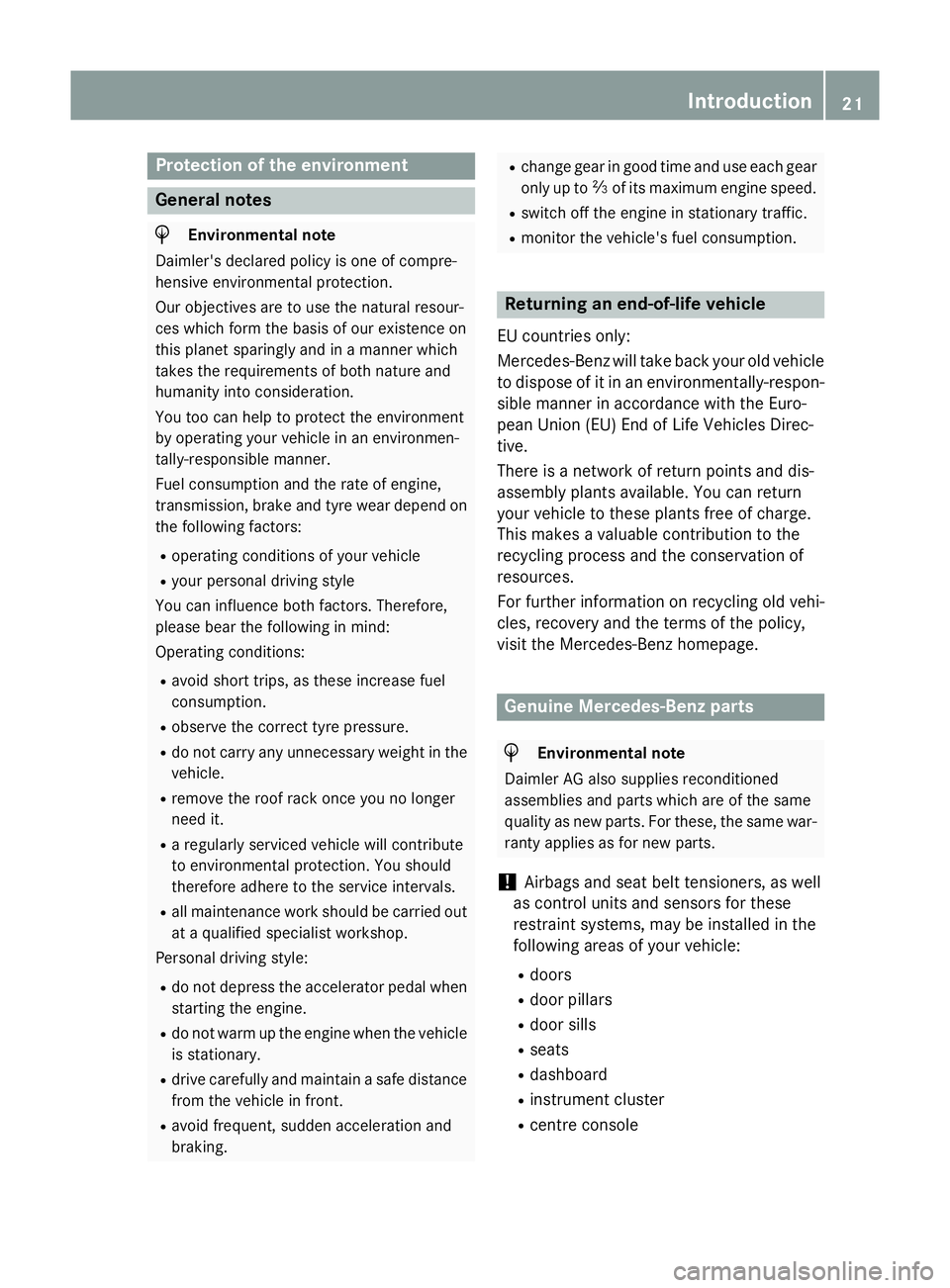
Protection of the environment
General notes
H
Environmental note
Daimler's declared policy is one of compre-
hensive environmental protection.
Our objectives are to use the natural resour-
ces which form the basis of our existence on
this planet sparingly and in a manner which
takes the requirements of both nature and
humanity into consideration.
You too can help to protect the environment
by operating your vehicle in an environmen-
tally-responsible manner.
Fuel consumption and the rate of engine,
transmission, brake and tyre wear depend on
the following factors:
R operating conditions of your vehicle
R your personal driving style
You can influence both factors. Therefore,
please bear the following in mind:
Operating conditions:
R avoid short trips, as these increase fuel
consumption.
R observe the correct tyre pressure.
R do not carry any unnecessary weight in the
vehicle.
R remove the roof rack once you no longer
need it.
R a regularly serviced vehicle will contribute
to environmental protection. You should
therefore adhere to the service intervals.
R all maintenance work should be carried out
at a qualified specialist workshop.
Personal driving style:
R do not depress the accelerator pedal when
starting the engine.
R do not warm up the engine when the vehicle
is stationary.
R drive carefully and maintain a safe distance
from the vehicle in front.
R avoid frequent, sudden acceleration and
braking. R
change gear in good time and use each gear
only up to Ôof its maximum engine speed.
R switch off the engine in stationary traffic.
R monitor the vehicle's fuel consumption. Returning an end-of-life vehicle
EU countries only:
Mercedes-Benz will take back your old vehicle to dispose of it in an environmentally-respon-sible manner in accordance with the Euro-
pean Union (EU) End of Life Vehicles Direc-
tive.
There is a network of return points and dis-
assembly plants available. You can return
your vehicle to these plants free of charge.
This makes a valuable contribution to the
recycling process and the conservation of
resources.
For further information on recycling old vehi- cles, recovery and the terms of the policy,
visit the Mercedes-Benz homepage. Genuine Mercedes-Benz parts
H
Environmental note
Daimler AG also supplies reconditioned
assemblies and parts which are of the same
quality as new parts. For these, the same war-
ranty applies as for new parts.
! Airbags and seat belt tensioners, as well
as control units and sensors for these
restraint systems, may be installed in the
following areas of your vehicle:
R doors
R door pillars
R door sills
R seats
R dashboard
R instrument cluster
R centre console Introduction
21 Z
Page 55 of 373
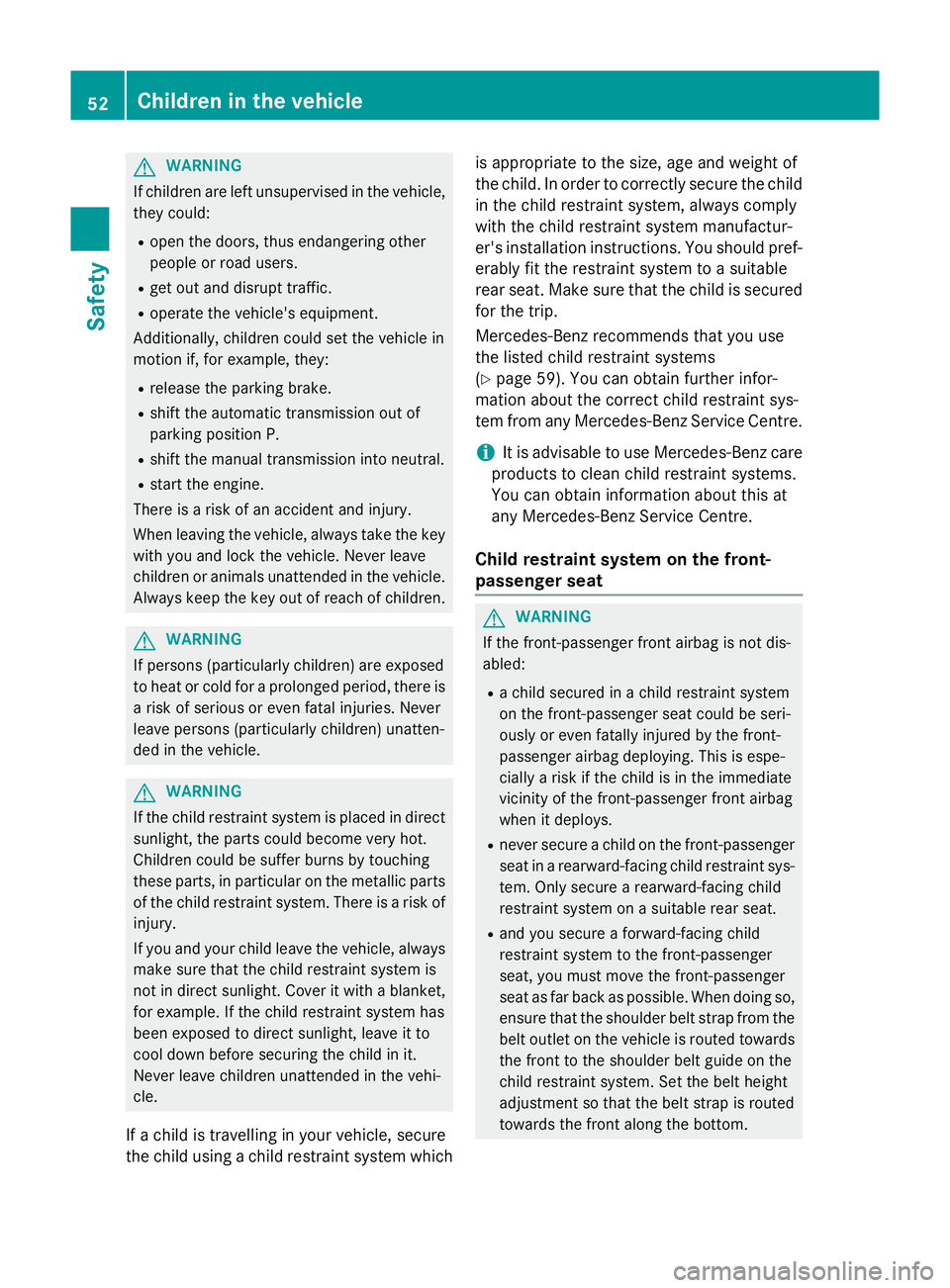
G
WARNING
If children are left unsupervised in the vehicle, they could:
R open the doors, thus endangering other
people or road users.
R get out and disrupt traffic.
R operate the vehicle's equipment.
Additionally, children could set the vehicle in
motion if, for example, they:
R release the parking brake.
R shift the automatic transmission out of
parking position P.
R shift the manual transmission into neutral.
R start the engine.
There is a risk of an accident and injury.
When leaving the vehicle, always take the key with you and lock the vehicle. Never leave
children or animals unattended in the vehicle.Always keep the key out of reach of children. G
WARNING
If persons (particularly children) are exposed
to heat or cold for a prolonged period, there is a risk of serious or even fatal injuries. Never
leave persons (particularly children) unatten-
ded in the vehicle. G
WARNING
If the child restraint system is placed in direct sunlight, the parts could become very hot.
Children could be suffer burns by touching
these parts, in particular on the metallic parts
of the child restraint system. There is a risk of injury.
If you and your child leave the vehicle, always
make sure that the child restraint system is
not in direct sunlight. Cover it with a blanket, for example. If the child restraint system has
been exposed to direct sunlight, leave it to
cool down before securing the child in it.
Never leave children unattended in the vehi-
cle.
If a child is travelling in your vehicle, secure
the child using a child restraint system which is appropriate to the size, age and weight of
the child. In order to correctly secure the child
in the child restraint system, always comply
with the child restraint system manufactur-
er's installation instructions. You should pref- erably fit the restraint system to a suitable
rear seat. Make sure that the child is securedfor the trip.
Mercedes-Benz recommends that you use
the listed child restraint systems
(Y page 59). You can obtain further infor-
mation about the correct child restraint sys-
tem from any Mercedes-Benz Service Centre.
i It is advisable to use Mercedes-Benz care
products to clean child restraint systems.
You can obtain information about this at
any Mercedes-Benz Service Centre.
Child restraint system on the front-
passenger seat G
WARNING
If the front-passenger front airbag is not dis-
abled:
R a child secured in a child restraint system
on the front-passenger seat could be seri-
ously or even fatally injured by the front-
passenger airbag deploying. This is espe-
cially a risk if the child is in the immediate
vicinity of the front-passenger front airbag
when it deploys.
R never secure a child on the front-passenger
seat in a rearward-facing child restraint sys- tem. Only secure a rearward-facing child
restraint system on a suitable rear seat.
R and you secure a forward-facing child
restraint system to the front-passenger
seat, you must move the front-passenger
seat as far back as possible. When doing so,
ensure that the shoulder belt strap from the
belt outlet on the vehicle is routed towards
the front to the shoulder belt guide on the
child restraint system. Set the belt height
adjustment so that the belt strap is routed
towards the front along the bottom. 52
Children in the vehicleSafety
Page 57 of 373
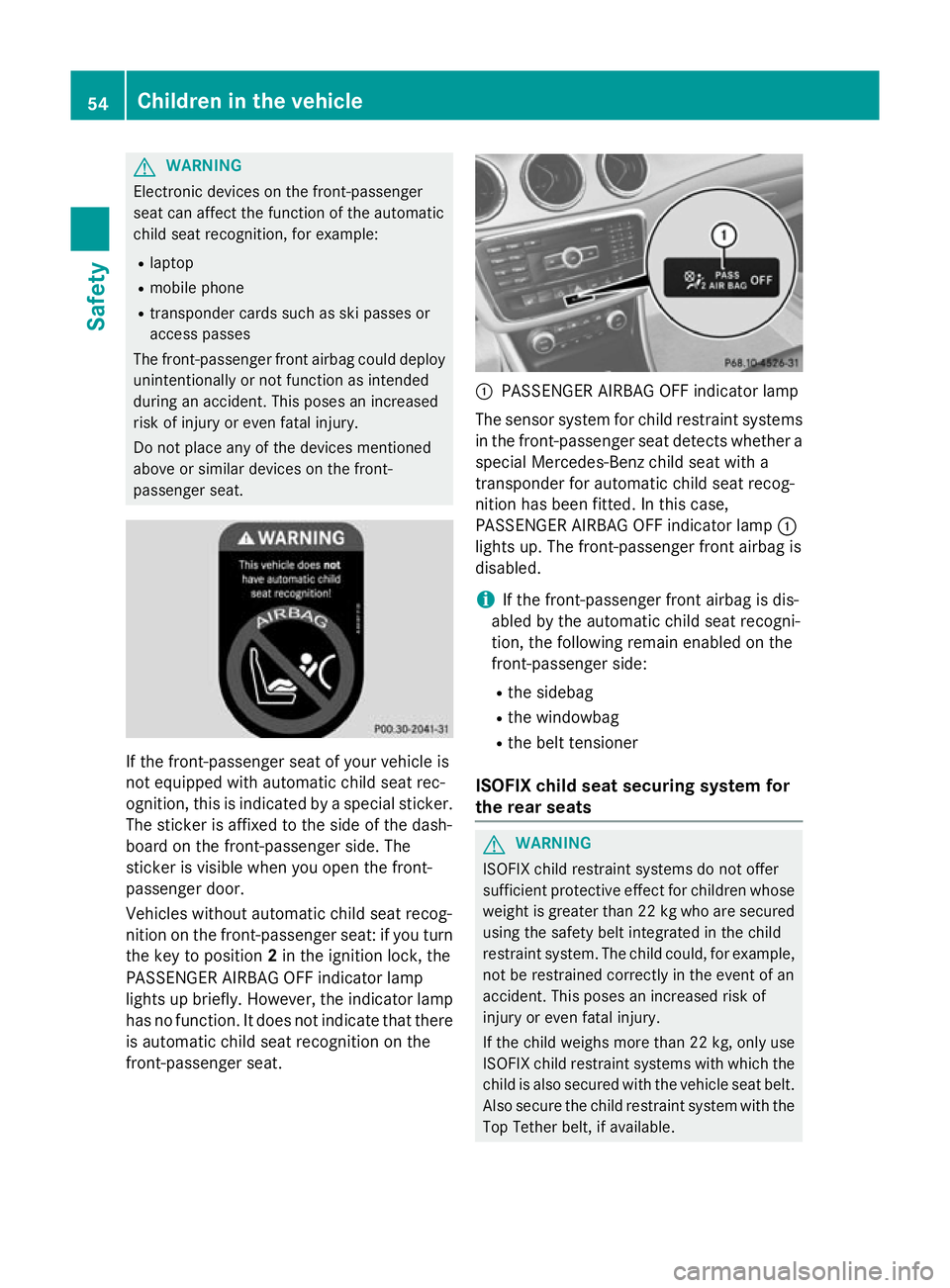
G
WARNING
Electronic devices on the front-passenger
seat can affect the function of the automatic
child seat recognition, for example:
R laptop
R mobile phone
R transponder cards such as ski passes or
access passes
The front-passenger front airbag could deploy unintentionally or not function as intended
during an accident. This poses an increased
risk of injury or even fatal injury.
Do not place any of the devices mentioned
above or similar devices on the front-
passenger seat. If the front-passenger seat of your vehicle is
not equipped with automatic child seat rec-
ognition, this is indicated by a special sticker. The sticker is affixed to the side of the dash-
board on the front-passenger side. The
sticker is visible when you open the front-
passenger door.
Vehicles without automatic child seat recog-
nition on the front-passenger seat: if you turn
the key to position 2in the ignition lock, the
PASSENGER AIRBAG OFF indicator lamp
lights up briefly. However, the indicator lamp
has no function. It does not indicate that there is automatic child seat recognition on the
front-passenger seat. :
PASSENGER AIRBAG OFF indicator lamp
The sensor system for child restraint systems
in the front-passenger seat detects whether a special Mercedes-Benz child seat with a
transponder for automatic child seat recog-
nition has been fitted. In this case,
PASSENGER AIRBAG OFF indicator lamp :
lights up. The front-passenger front airbag is
disabled.
i If the front-passenger front airbag is dis-
abled by the automatic child seat recogni-
tion, the following remain enabled on the
front-passenger side:
R the sidebag
R the windowbag
R the belt tensioner
ISOFIX child seat securing system for
the rear seats G
WARNING
ISOFIX child restraint systems do not offer
sufficient protective effect for children whose weight is greater than 22 kg who are securedusing the safety belt integrated in the child
restraint system. The child could, for example,not be restrained correctly in the event of an
accident. This poses an increased risk of
injury or even fatal injury.
If the child weighs more than 22 kg, only use
ISOFIX child restraint systems with which the child is also secured with the vehicle seat belt. Also secure the child restraint system with the
Top Tether belt, if available. 54
Children in the vehicleSafety
Page 60 of 373

Suitable positioning of the child restraint systems
Only child restraint systems which are approved in accordance with the ECE standard ECE R44
are permitted for use in the vehicle.
Suitability of the seats for attaching belted child restraint systems
Key to the letters used in the table:
XS eat which is unsuitable for children in this weight category
US uitable for child restraint systems in the "Universal" category that are approved for use
in this weight category
UF Suitable for forward-facing child restraint systems that belong to the "Universal" category and are approved for use in this weight category
LS uitable for child restraint systems as recommended; see the following table of "Recom-
mended child restraint systems" (Y page 59). Suitable for semi-universal child restraint
systems if the vehicle and the seat are listed in the child restraint system manufacturer's
vehicle model list. Seat positions
Weight catego-
ries Front-passenger seat
Rear seat
1 Front-
passenger
front airbag is
not disabled Front-
passenger
front airbag is
disabled Left, right Centre
Category 0: up
to 10 kg X
L
2, 3 U, L
U, L
4 Category 0+:
up to 13 kg
X
L
2, 3 U, L
U, L
4 Category I:
9to
18 kg UF
3
, L 3 UF
3
, L 3 U, L
U, L
4 1
If you use a baby car seat from category 0 or 0+ or a rearward-facing child restraint system from category I
on a rear seat, you must adjust the driver's or front-passenger seat so that the seat does not touch the
rearward-facing child restraint.
2 Vehicles with automatic child seat recognition in the front-passenger seat: a child restraint system from the
"Universal" category with a transponder for automatic child seat recognition must be fitted. The PASSENGER AIRBAG OFF indicator lamp must be lit.
3 Move the front-passenger seat as far back as possible. If you secure a child in a forward-facing child restraint
system on the front-passenger seat, ensure that the shoulder belt strap from the belt outlet on the vehicle is
routed towards the front to the shoulder belt guide on the child restraint system. Set the belt height adjust-
ment so that the belt strap is routed towards the front along the bottom. Move the front-passenger seat to the highest position and move the backrest to an almost vertical position. When doing so, ensure that the com-plete surface of the child restraint system rests against the backrest of the front-passenger seat and that the
child restraint system does not touch the roof. To do so, you may have to adjust the backrest down a little. For seats with electrical adjustment, the seat cushion angle must be set to the highest and most upright position.
4 Child restraint systems with a supporting bracket are not suitable for this seat. Children in the vehicle
57Safety Z
Page 61 of 373
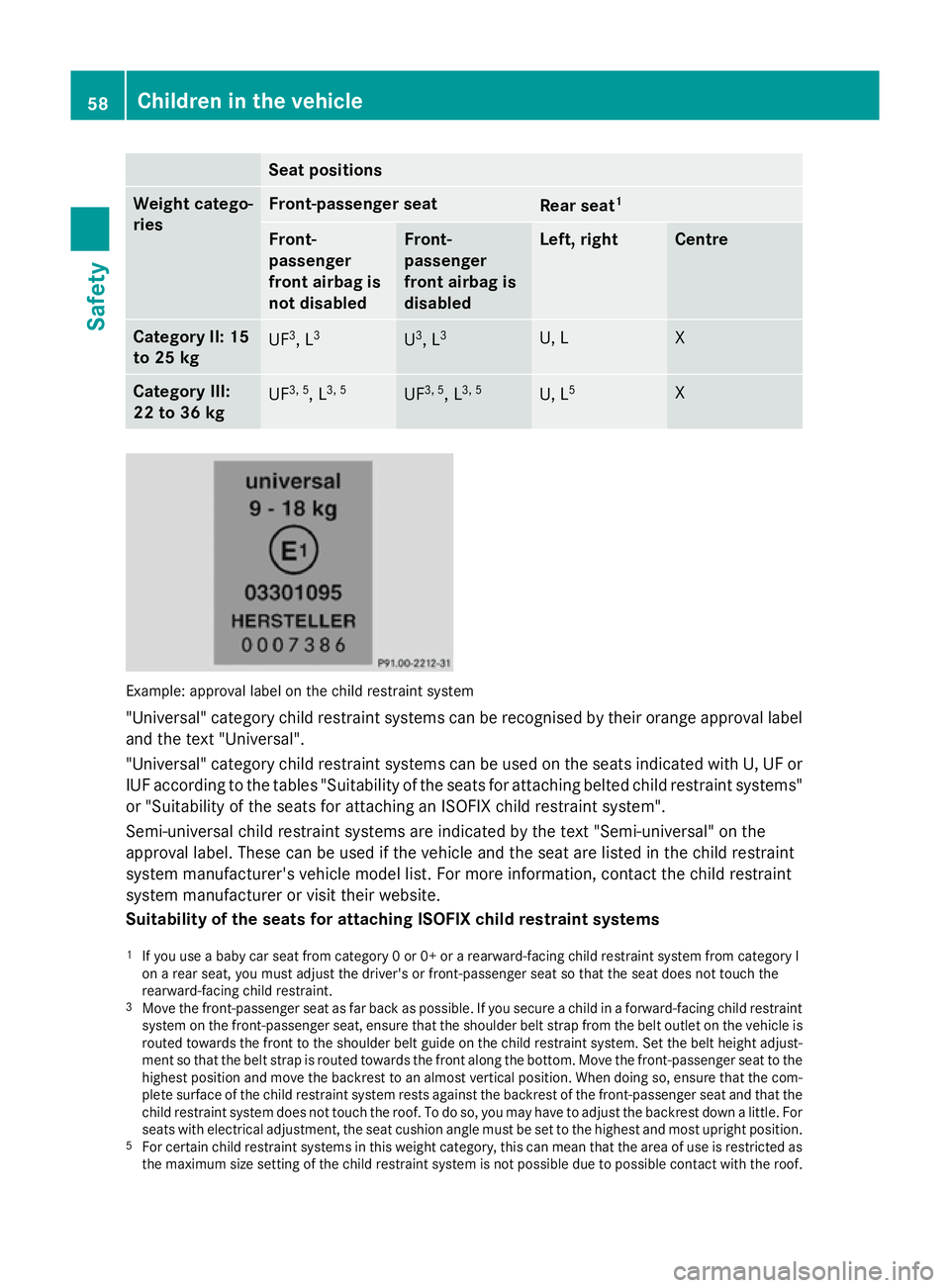
Seat positions
Weight catego-
ries Front-passenger seat
Rear seat
1 Front-
passenger
front airbag is
not disabled Front-
passenger
front airbag is
disabled Left, right Centre
Category II: 15
to 25 kg UF
3
, L 3 U
3
, L 3 U, L X
Category III:
22 to 36 kg
UF
3, 5
, L3, 5 UF
3, 5
, L3, 5 U, L
5 X
Example: approval label on the child restraint system
"Universal" category child restraint systems can be recognised by their orange approval label and the text "Universal".
"Universal" category child restraint systems can be used on the seats indicated with U, UF or
IUF according to the tables "Suitability of the seats for attaching belted child restraint systems"
or "Suitability of the seats for attaching an ISOFIX child restraint system".
Semi-universal child restraint systems are indicated by the text "Semi-universal" on the
approval label. These can be used if the vehicle and the seat are listed in the child restraint
system manufacturer's vehicle model list. For more information, contact the child restraint
system manufacturer or visit their website.
Suitability of the seats for attaching ISOFIX child restraint systems
1 If you use a baby car seat from category 0 or 0+ or a rearward-facing child restraint system from category I
on a rear seat, you must adjust the driver's or front-passenger seat so that the seat does not touch the
rearward-facing child restraint.
3 Move the front-passenger seat as far back as possible. If you secure a child in a forward-facing child restraint
system on the front-passenger seat, ensure that the shoulder belt strap from the belt outlet on the vehicle is routed towards the front to the shoulder belt guide on the child restraint system. Set the belt height adjust-
ment so that the belt strap is routed towards the front along the bottom. Move the front-passenger seat to the
highest position and move the backrest to an almost vertical position. When doing so, ensure that the com- plete surface of the child restraint system rests against the backrest of the front-passenger seat and that thechild restraint system does not touch the roof. To do so, you may have to adjust the backrest down a little. For seats with electrical adjustment, the seat cushion angle must be set to the highest and most upright position.
5 For certain child restraint systems in this weight category, this can mean that the area of use is restricted as
the maximum size setting of the child restraint system is not possible due to possible contact with the roof. 58
Children in the vehicleSafety
Page 62 of 373
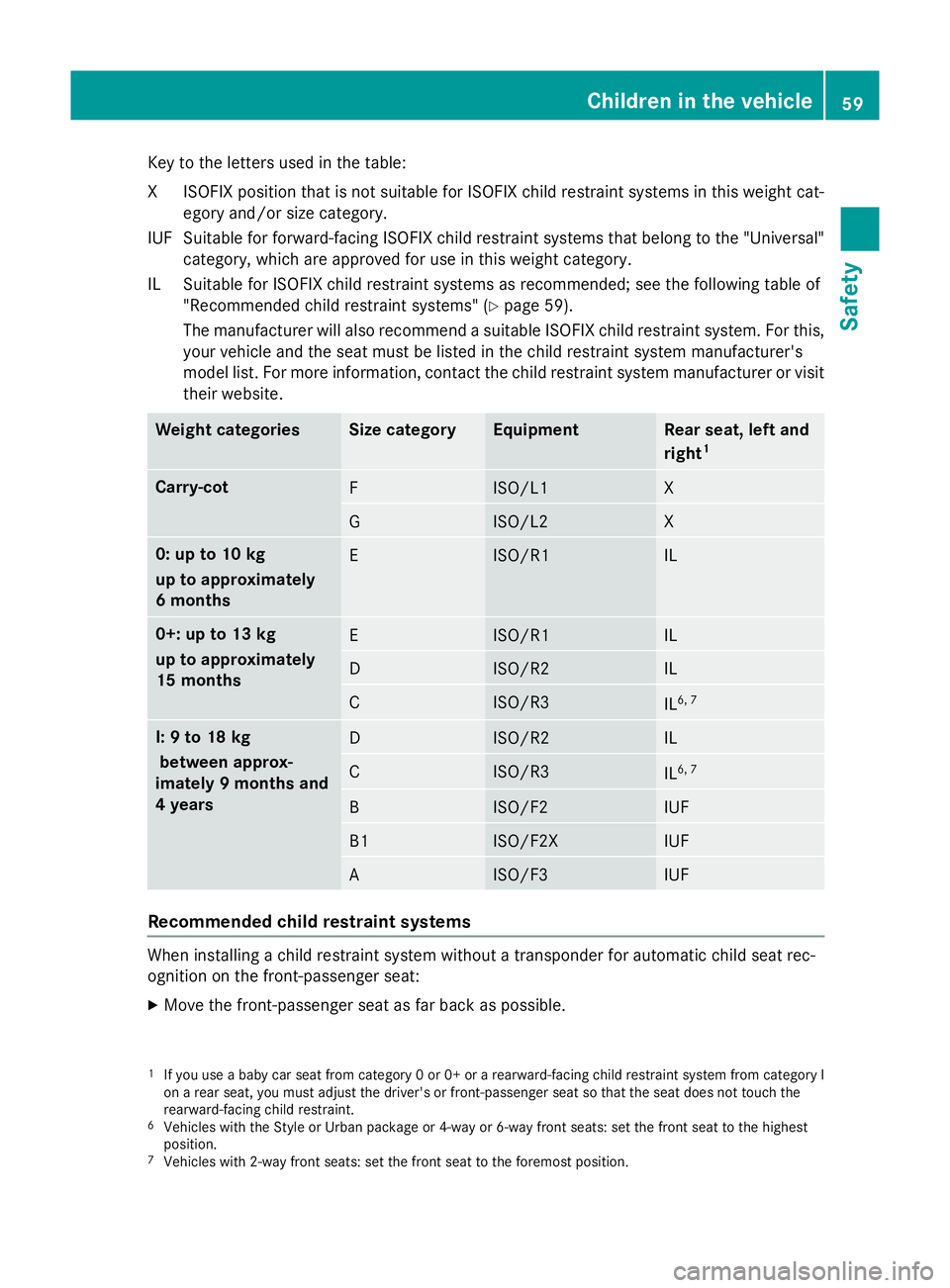
Key to the letters used in the table:
XI SOFIX position that is not suitable for ISOFIX child restraint systems in this weight cat-
egory and/or size category.
IUF Suitable for forward-facing ISOFIX child restraint systems that belong to the "Universal" category, which are approved for use in this weight category.
IL Suitable for ISOFIX child restraint systems as recommended; see the following table of "Recommended child restraint systems" (Y page 59).
The manufacturer will also recommend a suitable ISOFIX child restraint system. For this,
your vehicle and the seat must be listed in the child restraint system manufacturer's
model list. For more information, contact the child restraint system manufacturer or visit
their website. Weight categories Size category Equipment Rear seat, left and
right
1 Carry-cot
F ISO/L1 X
G ISO/L2 X
0: up to 10 kg
up to approximately
6 months
E ISO/R1 IL
0+: up to 13 kg
up to approximately
15 months
E ISO/R1 IL
D ISO/R2 IL
C ISO/R3
IL
6, 7 I: 9 to 18 kg
between approx-
imately 9 months and
4 years D ISO/R2 IL
C ISO/R3
IL
6, 7 B ISO/F2 IUF
B1 ISO/F2X IUF
A ISO/F3 IUF
Recommended child restraint systems
When installing a child restraint system without a transponder for automatic child seat rec-
ognition on the front-passenger seat:
X Move the front-passenger seat as far back as possible.
1 If you use a baby car seat from category 0 or 0+ or a rearward-facing child restraint system from category I
on a rear seat, you must adjust the driver's or front-passenger seat so that the seat does not touch the
rearward-facing child restraint.
6 Vehicles with the Style or Urban package or 4-way or 6-way front seats: set the front seat to the highest
position.
7 Vehicles with 2-way front seats: set the front seat to the foremost position. Children in the vehicle
59Safety Z
Page 63 of 373
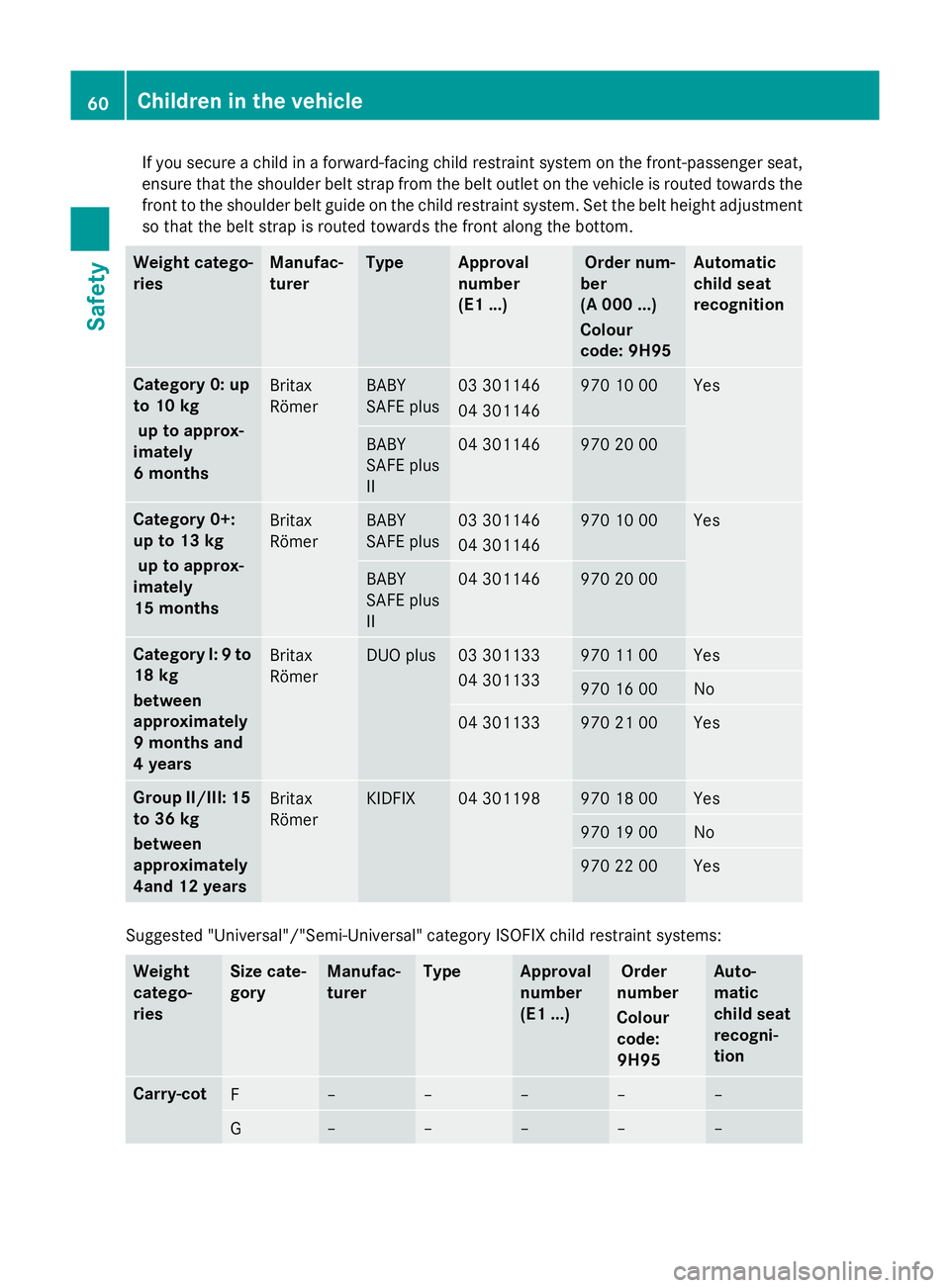
If you secure a child in a forward-facing child restraint system on the front-passenger seat,
ensure that the shoulder belt strap from the belt outlet on the vehicle is routed towards the front to the shoulder belt guide on the child restraint system. Set the belt height adjustment
so that the belt strap is routed towards the front along the bottom. Weight catego-
ries Manufac-
turer Type Approval
number
(E1 ...) Order num-
ber
(A 000 ...)
Colour
code: 9H95 Automatic
child seat
recognition
Category 0: up
to 10 kg
up to approx-
imately
6 months Britax
Römer BABY
SAFE plus 03 301146
04 301146 970 10 00 Yes
BABY
SAFE plus
II 04 301146 970 20 00
Category 0+:
up to 13 kg
up to approx-
imately
15 months Britax
Römer BABY
SAFE plus 03 301146
04 301146 970 10 00 Yes
BABY
SAFE plus
II 04 301146 970 20 00
Category I:
9to
18 kg
between
approximately
9 months and
4 years Britax
Römer DUO plus 03 301133
04 301133 970 11 00 Yes
970 16 00 No
04 301133 970 21 00 Yes
Group II/III: 15
to 36 kg
between
approximately
4and 12 years Britax
Römer KIDFIX 04 301198 970 18 00 Yes
970 19 00 No
970 22 00 Yes
Suggested "Universal"/"Semi-Universal" category ISOFIX child restraint systems:
Weight
catego-
ries Size cate-
gory Manufac-
turer Type Approval
number
(E1 ...) Order
number
Colour
code:
9H95 Auto-
matic
child seat
recogni-
tion Carry-cot
F – – – – –
G – – – – –60
Children in the vehicleSafety